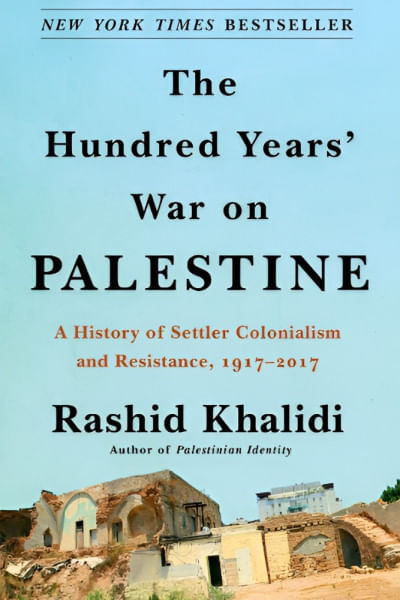Reading The Hundred Years' War on Palestine: A History of Settler Colonialism and Resistance, 1917–2017 by Rashid Khalidi in the midst of Israel's genocidal bombing and starvation of Gaza is both illuminating and depressing. Khalidi, a professor of history at Columbia University, describes the last century in terms of several "turning points", each of which he refers to as a distinct "declaration of war" against the Palestinians.
The "first declaration of war" was the 1917 Balfour Declaration, with which "His Majesty's government view with favour the establishment in Palestine of a national home for the Jewish people" (page 24). The British government of Palestine, which took over the region following the demise of Ottoman Turkish rule at the end of the First World War, thus agreed to the demands of European Jewish nationalists (or Zionists) who were inspired by Theodor Herzl's 1890s proposal for this homeland as a solution to the violent anti-semitism which Jews had experienced in Europe In keeping with the racist ideologies long used to justify the British Empire and other European colonialist projects, "The Jewish state, Herzl wrote, would 'form a part of a wall of defense for Europe in Asia, an outpost of civilization against barbarism" (page 10). In keeping with these racist European attitudes, little thought was spared for the indigenous Palestinian population who would be displaced by European immigrants: "Balfour ascribed national rights to what he called 'the Jewish people, who in 1917 were a tiny minority — only six percent — of the country's inhabitants" (page 24).

The colonial nature of the displacement is apparent: it was initially enabled by purchases of large tracts of rural land from city-dwelling absentee Palestinian landlords by "the Jewish Colonization Association (in 1924 renamed the Palestine Jewish Colonization Association)" (page 13). The British brutally suppressed any attempt by Palestinians to oppose their policy to colonise Palestine with Zionist immigrants, especially during the Great Arab Revolt of 1936–39, during which "10 percent of the adult male population was killed, wounded, imprisoned or exiled… Meanwhile, a massive wave of Jewish immigration as a result of Nazi persecution in Germany raised the Jewish population in Palestine from just 18 percent of the total in 1932 to over 31 percent in 1939" (page 8).
The "second declaration of war" was the armed conflict between Zionist immigrants from Europe and indigenous Palestinians in 1948 upon British withdrawal. Under the UN partition plan, the Jewish population — only one-third of Palestine's inhabitants — was allocated more than half of the territory for the proposed state of Israel. It seems remarkable in retrospect that the newly formed UN approved such an unfair deal; the explanation is the behind-the-scenes action of a powerful "Israel lobby" on US President Truman. "In November 1945… Truman bluntly revealed… 'I have to answer to hundreds of thousands who are anxious for the success of Zionism. I do not have hundreds of thousands of Arabs among my constituents" (page 79). The UN plan was rejected by Palestinians, but to no avail: they had already been crushed by the British during the Arab Revolt just a few years earlier, and were in no position to resist. Heavily armed Zionist militias terrorised the Palestinian population: "People fled as news spread of massacres like that on April 9, 1948, in the village of Deyr Yasin near Jerusalem, where one hundred residents, sixty-seven of them women, children and old people, were slaughtered" (page 74). Palestinians recall this defeat as the Nakba, or catastrophe: "Eighty percent of the Arab population of the territory that at war's end became the new state of Israel had been forced from their homes… At least 720,000 of the 1.3 million Palestinians were made refugees" (page 58).
The "third declaration of war" was the Israeli defeat of neighbouring Arab states during the Six Day War of 1967, which established Israel as militarily strongest in the region. In the context of the Cold War, Israel henceforth became the chosen ally of the US to oppose the socialist Arab states of Egypt and Syria, which were Soviet-aligned. The Israeli occupation of the West Bank and Gaza subjected the Palestinians to apartheid-like conditions, surrounded by Israeli settlements which, though illegal under international law, were given preference in rights to land, water, road access and military protection.

The "fourth declaration of war" was the 1982 Israeli invasion of Lebanon and the destruction of Yassir Arafat's Palestine Liberation Organisation operations there. This culminated in the massacre of over a thousand Palestinians in the Sabra and Shatila camps.
The "fifth declaration of war" was the first "intifada" or uprising, an originally non-violent resistance movement which was started in 1987 by unarmed Palestinian civilians protesting their lack of rights under the Israeli occupation. Over 1,000 Palestinians were killed, one-fourth of them children.
The sixth and final phase of the war on Palestine mentioned by Khalidi was the repeated Israeli attacks on Gaza in 2008, 2012 and 2014. Khalidi's book ends here, as it was published in 2020. But the current genocidal bombing and starvation of Gaza is obviously an escalation of this phase of the war.
Khalidi's narrative makes abundantly clear that the standard Israeli line, that the current Gaza war started with the Hamas attack of October 7, 2023, is obviously false. The Zionist settler-colonialist plan to conquer and occupy more and more land by force is still the strategy of the Netanyahu government. One can only hope that the younger generations of Americans and Europeans, whose governments supported both Israel's ethnic cleansing in 1947 and establishment of apartheid in the occupied territories in 1967, will finally draw the line at the starvation and genocide of Gaza which is currently visible on their smartphones.
Zeeshan Hasan is director at Kazi Farms Ltd.


Comments